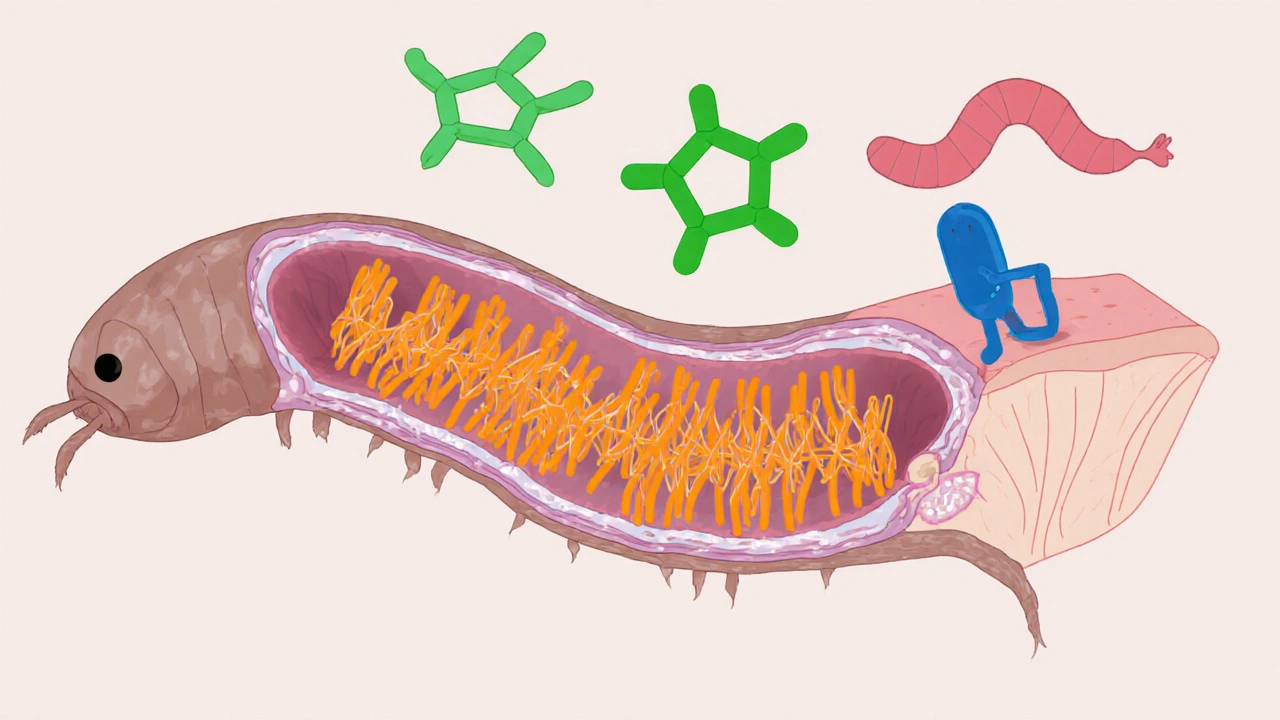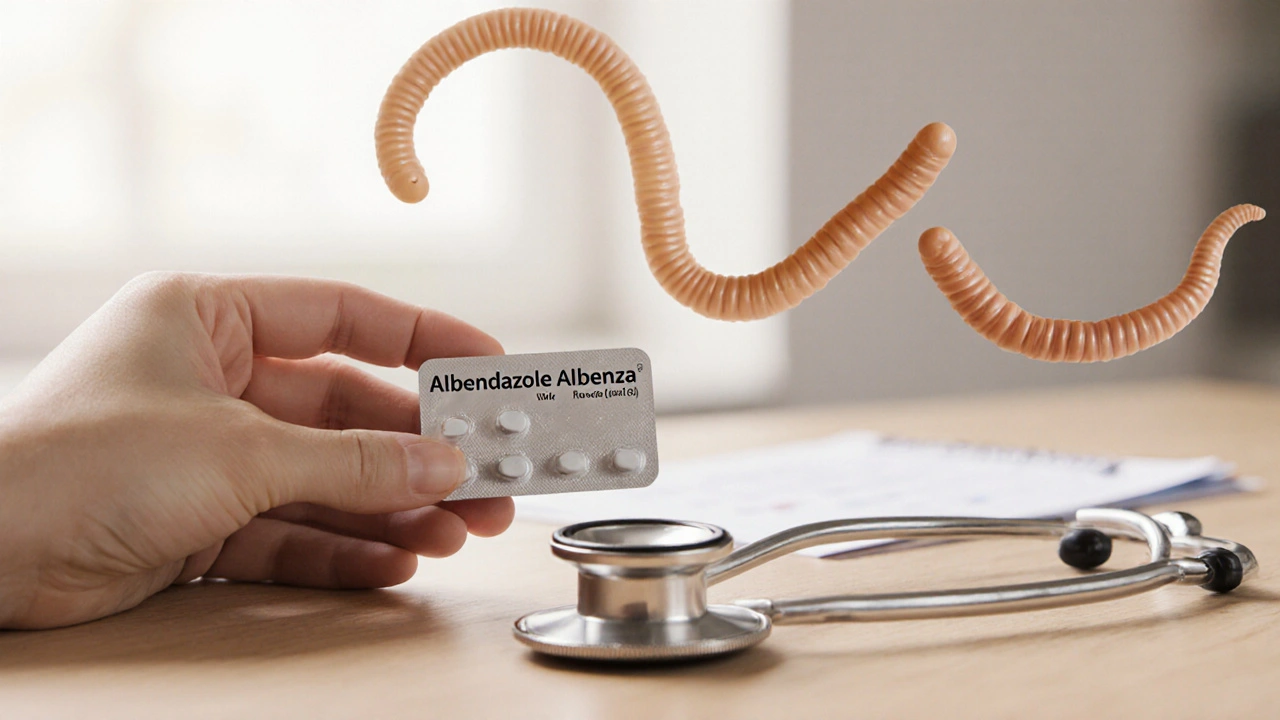Anthelmintic Selection Assistant
Recommended:
Select your options to see a personalized recommendation.
Quick Summary
- Albendazole (brand Albenza) covers a wide range of nematodes and some cestodes.
- Mebendazole is cheaper but less effective against tapeworms.
- Ivermectin excels for skin‑related parasites but isn’t first‑line for intestinal worms.
- Praziquantel is the drug of choice for tapeworm and fluke infections.
- Choosing the right drug depends on parasite type, safety profile, cost, and local resistance patterns.
When a doctor prescribes an anthelmintic, the decision hinges on the specific parasite, patient health, and drug availability. Albendazole is often the go‑to option, but there are several alternatives that may work better in certain scenarios. This guide breaks down how Albendazole stacks up against its most common competitors, what each drug actually does, and how to pick the safest, most effective choice for you.
What Is Albendazole?
When treating helminth infections, Albendazole is a broad‑spectrum anthelmintic that targets roundworms, hookworms, and certain tapeworms. It belongs to the benzimidazole class and works by binding to tubulin proteins, which cripples the parasite’s glucose uptake and eventually kills it. The brand version sold in the U.S. is called Albenza, approved by the FDA for several indications, including neurocysticercosis and hydatid disease.
How Albendazole Works
Albendazole’s mechanism is simple yet powerful: it inhibits the formation of microtubules in the parasite’s cells. Without a functional microtubule network, the worm cannot transport nutrients, leading to energy depletion and death within 24-48hours. This action is parasite‑selective because human cells have a different tubulin isoform, which explains the relatively low toxicity in most patients.

Key Attributes of Albendazole
- Spectrum: Effective against most nematodes (Ascaris, hookworm, Trichuris) and some cestodes (Echinococcus, Taenia solium larvae).
- Typical adult dose: 400mg once daily for 3days (or a single 400mg dose for pinworm).
- Common side effects: Mild abdominal pain, nausea, headache; rare liver enzyme elevation.
- Cost: Approximately $15-$30 for a full course in the U.S.
Popular Alternatives
Below are the most frequently prescribed drugs that compete with Albendazole in the anthelmintic arena.
Mebendazole
Mebendazole is another benzimidazole, often used for common intestinal worms like roundworm and hookworm. It’s cheaper than Albendazole but has a narrower spectrum-it’s not reliable against tapeworm larvae.
Ivermectin
Ivermectin shines for skin‑related parasites (scabies, lice) and some filarial infections (river blindness). It does not work well for most intestinal nematodes, so it’s rarely a direct substitute for Albendazole in those cases.
Praziquantel
Praziquantel is the drug of choice for tapeworms and flukes. Its rapid muscle‑spasm induction kills cestodes within hours. It’s not effective against most nematodes, which limits its use as a stand‑alone alternative to Albendazole.
Thiabendazole
Thiabendazole is an older benzimidazole still used in some veterinary settings and occasional human cases where resistance to Albendazole is suspected. Its side‑effect profile (nausea, dizziness) is less favorable.
Nitazoxanide
Nitazoxanide targets protozoa and some helminths (Giardia, Cryptosporidium). It’s sometimes paired with Albendazole for mixed infections but isn’t a full replacement.
Comparison Table
| Drug | Spectrum | FDA Approval (US) | Typical Adult Dose | Common Side Effects | Approx. Cost (US$) |
|---|---|---|---|---|---|
| Albendazole (Albenza) | Nematodes, some Cestodes | Yes | 400mg daily ×3days | Abdominal pain, nausea, headache | 15‑30 |
| Mebendazole | Nematodes only | Yes | 100mg twice daily ×3days | Flatulence, mild rash | 5‑12 |
| Ivermectin | Skin parasites, some filariae | Yes | 200µg/kg single dose | Dizziness, itching | 10‑20 |
| Praziquantel | Cestodes, Trematodes | Yes | 40mg/kg single dose | Headache, nausea | 25‑45 |
| Thiabendazole | Broad (Nematodes, Cestodes) | No (off‑label) | 25mg/kg daily ×5days | Nausea, dizziness | 30‑50 |
| Nitazoxanide | Protozoa, some helminths | Yes (for diarrhea) | 500mg twice daily ×3days | Stomach upset, headache | 20‑35 |
How to Choose the Right Anthelmintic
Here’s a quick decision‑tree you can run through with your clinician:
- Identify the parasite. If you have a confirmed nematode infection (e.g., Ascaris), Albendazole or Mebendazole are top picks.
- Check for mixed infections. When both nematodes and tapeworms are present, a combination of Albendazole + Praziquantel often works best.
- Consider safety. Patients with liver disease should avoid high‑dose Albendazole; Ivermectin or Nitazoxanide may be safer alternatives.
- Factor in cost and accessibility. In low‑resource settings, Mebendazole’s low price makes it a practical first line.
- Watch for resistance. Regions with documented benzimidazole resistance (some parts of Asia) may require Ivermectin or newer agents.

Safety, Interactions, and Pitfalls
All anthelmintics carry some risk. Albendazole can raise liver enzymes, so baseline liver function tests are recommended for prolonged courses. It also interacts with anticonvulsants like carbamazepine, which can lower its blood levels.
Ivermectin should not be taken with blood‑thinners, as it can increase bleeding risk. Praziquantel may cause transient visual disturbances, so avoid driving until you know how you react.
Pregnant women should steer clear of Albendazole and Mebendazole unless the infection is life‑threatening; Praziquantel is considered safer in the third trimester.
Practical Tips for Patients
- Take Albendazole with a fatty meal - absorption improves dramatically.
- Stay hydrated while on any anthelmintic to help the drug flush through the gut.
- Complete the full course even if symptoms disappear early; unfinished treatment can lead to recurrence.
- Report any severe abdominal pain, yellowing of skin, or unusual bruising to your doctor immediately.
Next Steps If You’re Unsure Which Drug to Use
If you’ve been diagnosed with a worm infection but aren’t sure which medication fits your case, schedule a follow‑up with your healthcare provider. Bring a list of any current medications, existing health conditions, and a note of any recent travel; this information helps the clinician match you with the safest, most effective drug.
Frequently Asked Questions
Can I take Albendazole and Mebendazole together?
Combining the two isn’t usually necessary because they belong to the same drug class and act on the same parasite mechanisms. Using both may increase side‑effects without adding benefit. Your doctor might prescribe a combo only if resistance is suspected.
Is Albendazole safe for children?
Yes, pediatric dosing is well‑studied. For children older than 2years, the usual dose is 200mg twice daily for 3days. Always follow the exact prescription, and monitor for any rash or stomach upset.
What if I miss a dose of Albendazole?
Take the missed dose as soon as you remember, unless it’s almost time for the next scheduled dose. In that case, skip the missed one-don’t double up. Completing the full regimen is more important than perfect timing.
Can I use over‑the‑counter dewormers instead of prescription Albendazole?
OTC options like pyrantel pamoate are effective for specific pinworm infections but lack the broad coverage Albendazole offers. If you have a confirmed nematode or mixed infection, prescription therapy is usually recommended.
How long does it take for symptoms to improve after taking Albendazole?
Most patients feel relief within 24-48hours as the parasites die. Full resolution of abdominal discomfort or anemia may take a week or two, depending on infection severity.


Jeremy Wessel
October 13, 2025 AT 19:33Albendazole works but watch the liver.
Laura Barney
October 27, 2025 AT 19:33When you’re weighing costs, think of albendazole as the premium‑quality option that still fits many budgets. It’s like getting a Swiss‑army knife versus a basic screwdriver – you pay a bit more but you’re covered for more parasites. If you’re dealing with a mixed infection, the combo of albendazole and praziquantel feels like a superhero team‑up. For pure nematodes, mebendazole can save you a few bucks while doing the job. Remember to take albendazole with a fatty meal; it’s a tiny trick that boosts absorption dramatically. Bottom line: pick the drug that matches both your parasite list and wallet, but never skimp on safety.
Jessica H.
November 10, 2025 AT 19:33The pharmacokinetics of albendazole dictate that a fatty meal enhances its bioavailability, a fact often overlooked in primary care. Its spectrum encompasses most nematodes and select cestodes, yet it lacks potency against trematodes. Patients with hepatic impairment should be monitored closely due to potential enzyme elevation. In contrast, mebendazole remains confined to nematodes and is less costly.
Patrick Fithen
November 24, 2025 AT 19:33Think of the parasite as a puzzle and the drug as the missing piece it needs to fall apart. Albendazole blocks glucose uptake, starving the worm. When that fails, praziquantel jumps in to paralyze tapeworms.
Michael Leaño
December 8, 2025 AT 19:33It’s easy to feel overwhelmed by the drug list, but you can simplify it. Identify whether you have roundworms, hookworms, or a tapeworm – that narrows the field. Albendazole is a solid all‑rounder for nematodes; mebendazole saves money if tapeworms aren’t a concern. For skin‑related parasites, ivermectin shines. And never forget to finish the full course, even if you start feeling better.